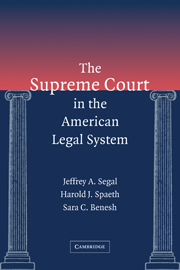Book contents
- Frontmatter
- Contents
- List of Illustrations
- List of Tables
- Preface
- I INTRODUCTION
- 1 Judicial Policy Making
- 2 Approaches to Judicial Decision Making
- 3 The Supreme Court in American Legal History
- II JUDICIAL PROCESS
- III LOWER COURTS IN THE AMERICAN LEGAL SYSTEM
- IV THE SUPREME COURT
- V IMPACT
- Case Index
- General Index
2 - Approaches to Judicial Decision Making
Published online by Cambridge University Press: 05 June 2012
- Frontmatter
- Contents
- List of Illustrations
- List of Tables
- Preface
- I INTRODUCTION
- 1 Judicial Policy Making
- 2 Approaches to Judicial Decision Making
- 3 The Supreme Court in American Legal History
- II JUDICIAL PROCESS
- III LOWER COURTS IN THE AMERICAN LEGAL SYSTEM
- IV THE SUPREME COURT
- V IMPACT
- Case Index
- General Index
Summary
Although judicial voting depends on variables more deeply rooted than political party affiliation, that does not gainsay that such affiliation is totally irrelevant or uncorrelated with the justices' values and attitudes. In a predecessor volume, two of us wrote – presciently, as it turned out – that “if a case on the outcome of a presidential election should reach the Supreme Court … the decision might well turn on the personal preferences of the justices.” Bush v. Gore, of course, admirably and accurately illustrates.
Given that judges make policy when they decide cases, attempting to provide explanations of how judges decide their cases becomes incumbent upon us.
In this chapter, we present and assess two broad approaches that are used to help us understand judicial decision making: a legal approach and an extralegal, policy-based approach. Beneath these broad approaches lie more specific models that animate or give life to these approaches.
At the most fundamental level, we can think of judges as pursuing two different types of goals when deciding cases. One goal might be to try to find the legally best answer to the case. That is, by weighing precedents, constitutional and statutory texts, the intent of the Framers, and other legally relevant criteria, the judge tries to come up with a “correct” answer to legal controversies. Alternatively, because judges themselves make public policy, they might wish those policies to reflect, as nearly as practicable, their personal policy preferences.
From these approaches flow more specific models.
- Type
- Chapter
- Information
- The Supreme Court in the American Legal System , pp. 19 - 40Publisher: Cambridge University PressPrint publication year: 2005

